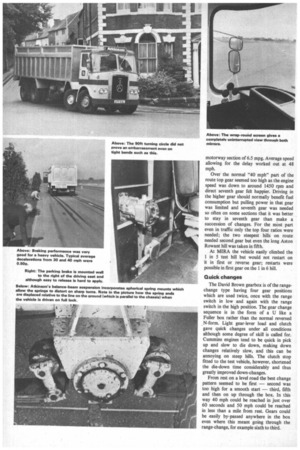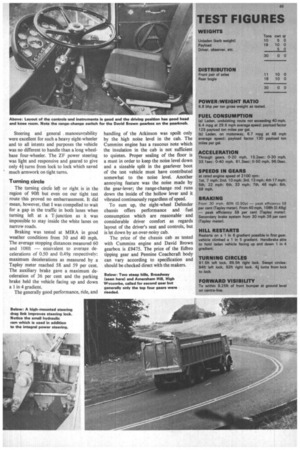ATKINSON DEFENDER 30-TON-GVW TIPPER
Page 48

Page 49

Page 50

Page 51

If you've noticed an error in this article please click here to report it so we can fix it.
and operational trial
SINCE the maximum permitted gross weight of eight-wheelers was raised to 30 tons the demand for this type of chassis on the British market has risen from about 450 to nearly 3000 units per year. Such a tremendous increase goes to show just how useful this configuration is, and many of these extra chassis are, I suspect, tippers which are able to make best use of the relatively short load space.
In the 30-ton eight-wheelers which it makes, Atkinson does not differentiate between chassis to be used as tippers or haulage vehicles apart from the length of frame members offered. Driveline and suspension are identical, even to the interaxle differential which is fitted as standard. No cross-axle differentials are available even for tipper chassis applications.
Because of the similarity of haulage and tipper chassis the Defender which we have recently had for assessment was tested at MIRA and over CM'S 194-mile Midlands road route.
The chassis on test was fitted with a Cummins NH-220 12-litre naturally aspirated diesel producing 215 bhp gross to BS AU 14Ia: 1971 — that is 204 bhp net installed. Drive was via a 14in. diameter Lipe Rollway clutch and David Brown 08750 gearbox to an Eaton 38 DS doubledrive bogie.
The Cummins engine is a standard option but the David Brown gearbox is not normally available in a rigid chassis. Tractive units have had the option of the David Brown box for some time and a decision is to be taken shortly as to whether to offer this gearbox on the rigids.
The aluminium Pennine Coachcraft tipper body is 24ft long and has a volume of 33 cu yd with the I ft 6in. extension "greedy" boards fitted. These extension boards allow for lower density payloads such as soil, denser materials such as the gravel used for the test load come well within the basic 3ft 6in. sides. Payload at 30 tons gross is 19.5 tons.
From the outside the Atkinson cab looks dated but inside it has some good sound features. The cab is very roomy by any standards and the driving position is pleasantly uncramped. The floor is flat apart from the engine cover and uncluttered. The driving position gives the impression of being planned around a big man as even at 6ft lin. I found the headroom and kneeroom ample.
All instruments are mounted on a semicircular dash panel which is mounted right in front of the driver. The main dials, speedometer and rev-counter, are viewed naturally through the upper half of the wheel. Brake and accelerator pedals are well placed but the clutch felt too far to the left at first.
I soon got used to the layout, however, as the action of all pedals was near perfect. The clutch was light to operate, the brake firm with no lost motion and the throttle very light.
Performance Performance can be best summed up as adequate rather than startling. On level motorway the vehicle would reach 55 mph and with only a slight gradient in its favour would reach 60 mph but only slight uphill gradients called for a down-change to seventh gear. Steeper hills such as the climb up from A5 intersection on the motorway required sixth gear and reduced our speed to 30 mph. Roadworks over about a mile of MI held us up for the equivalent of six minutes and perhaps contributed to the mediocre average fuel consumption over the
motorway section of 6.5 mpg. Average speed allowing for the delay worked out at 48 mph.
Over the normal "40 mph" part of the route top gear seemed too high as the engine speed was down to around 1450 rpm and direct seventh gear felt happier. Driving in the higher gear should normally benefit fuel consumption but pulling power in that gear was limited and seventh gear was needed so often on some sections that it was better to stay in seventh gear than make a succession of changes. For the most part even in traffic only the top four ratios were needed; the two steepest hills on route needed second gear but even the long Aston Rowant hill was taken in fifth.
At MIRA the vehicle easily climbed the 1 in 5 test hill but would not restart on it in first or reverse gear; restarts were possible in first gear on the 1 in 6 hill.
Quick changes
The David Brown gearbox is of the rangechange type having four gear positions which are used twice, once with the range switch in low and again with the range switch in the high position. The gear change sequence is in the form of a U like a Fuller box rather than the normal reversed .N-form. Light gear-lever load and clutch gave quick changes under all conditions although some degree of skill is called for. Cummins engines tend to be quick in pick up and slow to die down, making down changes relatively slow, and this can be annoying on steep hills. The clutch stop fitted to the test vehicle, however, shortened the die-down time considerably and thus greatly improved down-changes.
From rest on a level road the best change pattern seemed to be first — second was too high for a smooth start — third, fifth and then on up through the box. In this way 40 mph could be reached in just over 60 seconds and 50 mph could be reached in less than a mile from rest. Gears could be easily by-passed anywhere in the box even where this meant going through the range-change, for example sixth to third. Steering and general manoeuvrability were excellent for such a heavy eight-wheeler and to all intents and purposes the vehicle was no different to handle than a long wheelbase four-wheeler. The ZF power steering was light and responsive and geared to give only 4i turns from lock to lock which saved much armwork on tight turns.
Turning circle The turning circle left or right is in the region of 90ft but even on our tight test route this proved no embarrassment. It did mean, however, that I was compelled to wait for a gap in the traffic in both lanes when turning left at a T-junction as it was impossible to stay inside the white lanes on narrow roads.
Braking was tested at MIRA in good weather conditions from 30 and 40 mph. The average stopping distances measured 60 and 10811 — equivalent to average decelerations of 0.50 and 0.49g respectively: maximum decelerations as measured by a Tapley meter reached 58 and 59 per cent. The auxiliary brake gave a maximum deceleration of 36 per cent and the parking brake held the vehicle facing up and down a 1 in 4 gradient.
The generally good performance, ride, and handling of the Atkinson was spoilt only by the high noise level in the cab. The Cummins engine has a raucous note which the insulation in the cab is not sufficient to quieten. Proper sealing of the floor is a must in order to keep the noise level down and a sizeable split in the gearlever boot of the test vehicle must have contributed somewhat to the noise level. Another annoying feature was the noise made by the gear-lever; the range-change rod runs down the inside of the hollow lever and it vibrated continuously regardless of speed.
To sum up, the eight-wheel Defender chassis offers performance and fuel consumption which are reasonable and considerable driver comfort as regards layout of the driver's seat and controls, but is let down by an over-noisy cab.
The price of the chassis cab as tested with Cummins engine and David Brown gearbox is £9475. The price of the Edbro tipping gear and Pennine Coachcraft body can vary according to specification and should be checked direct with the makers.












































































































